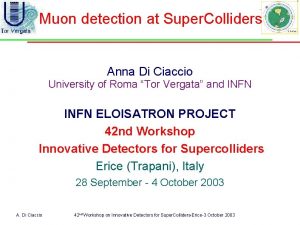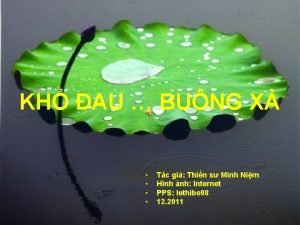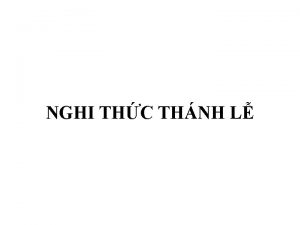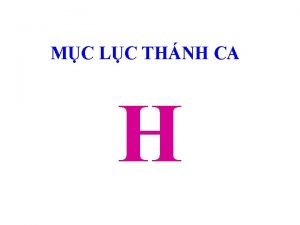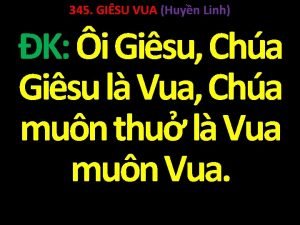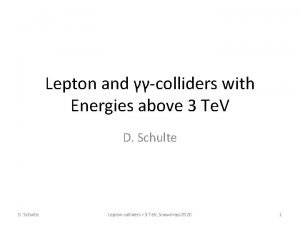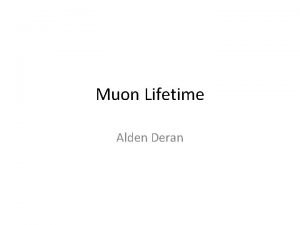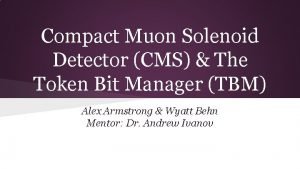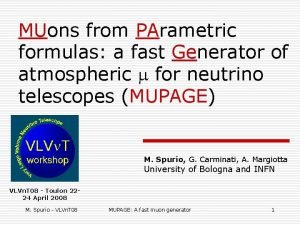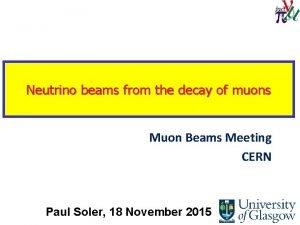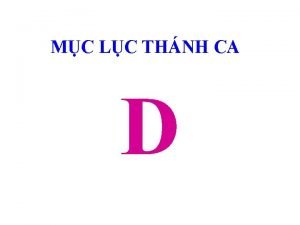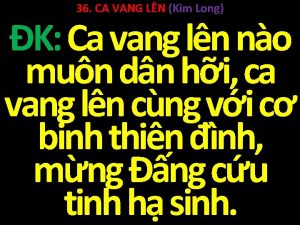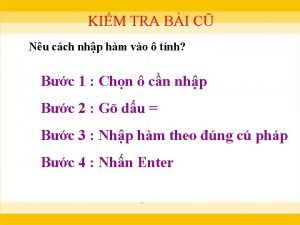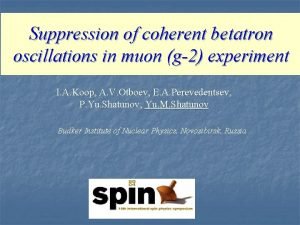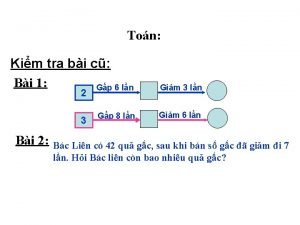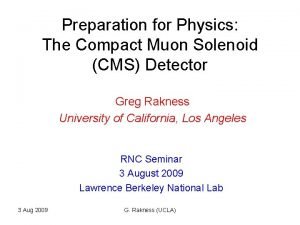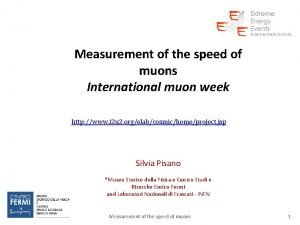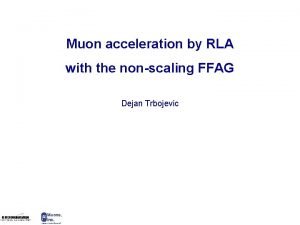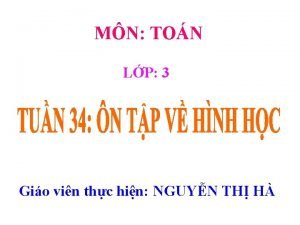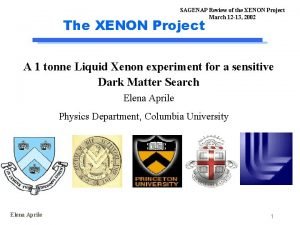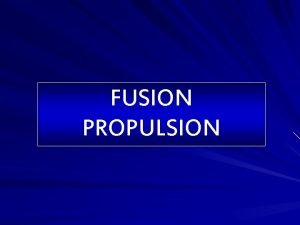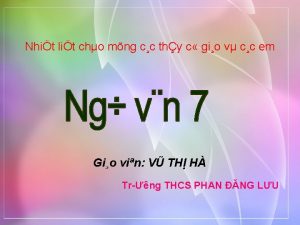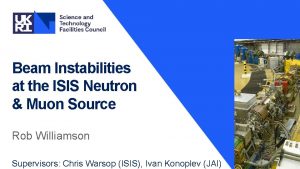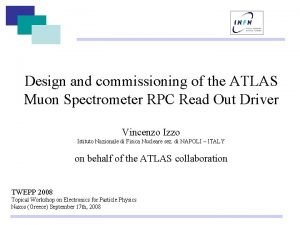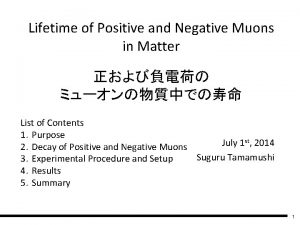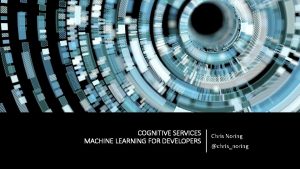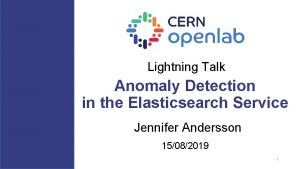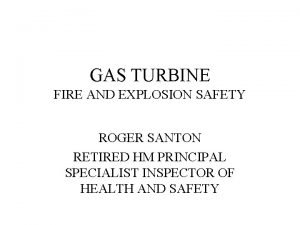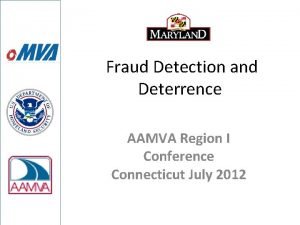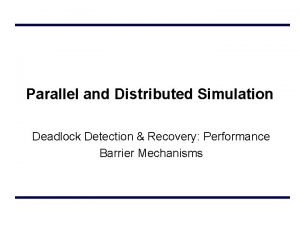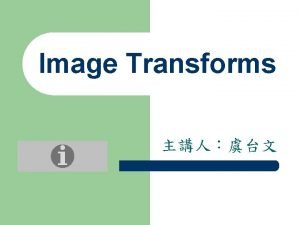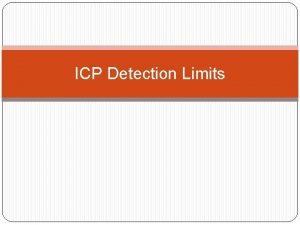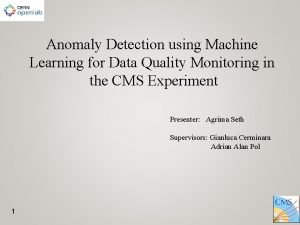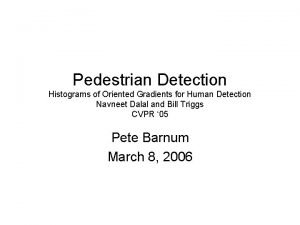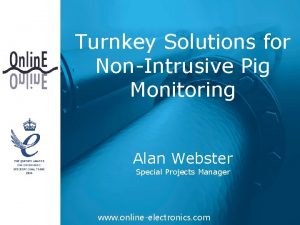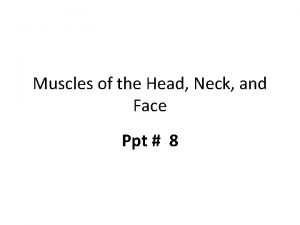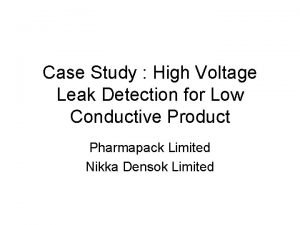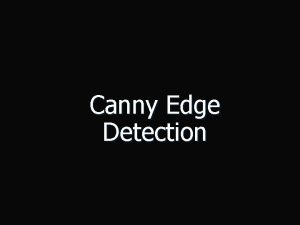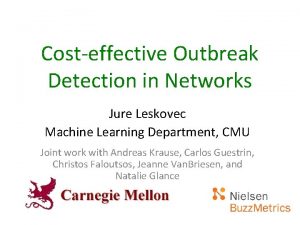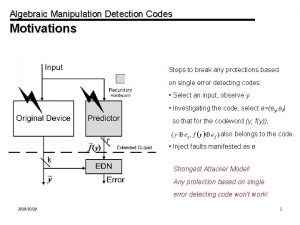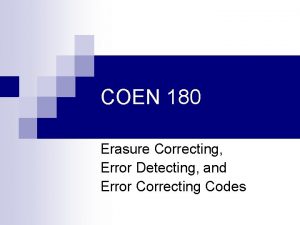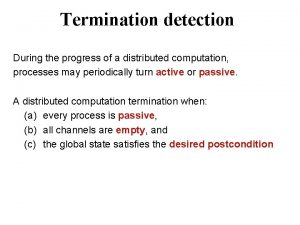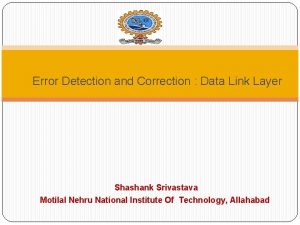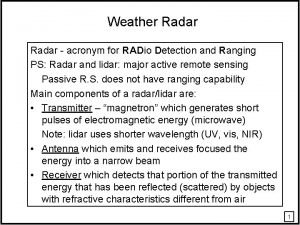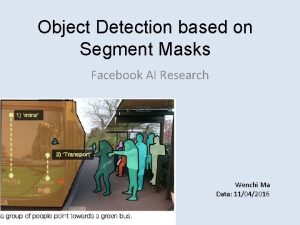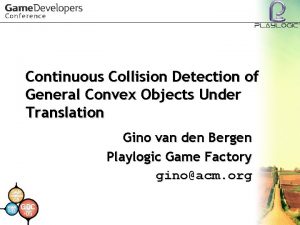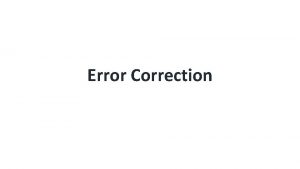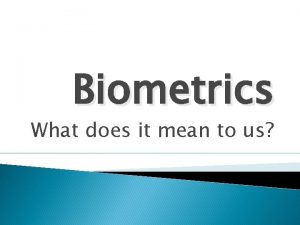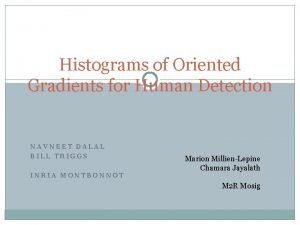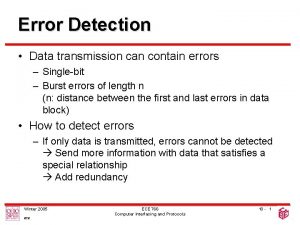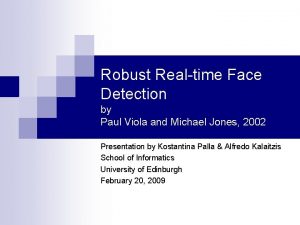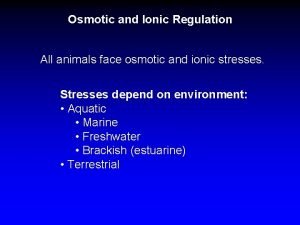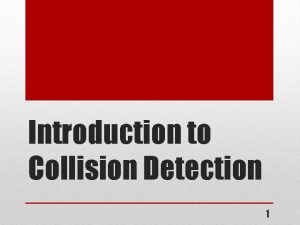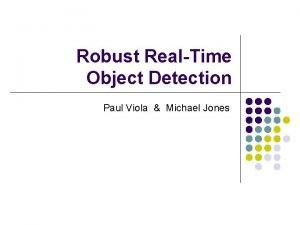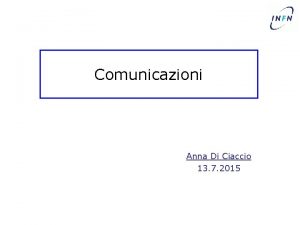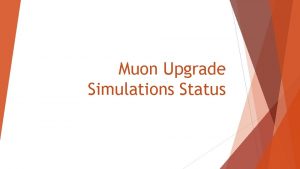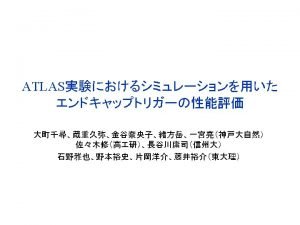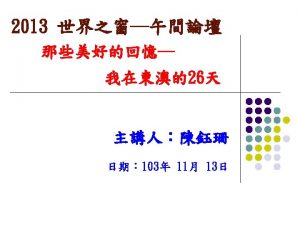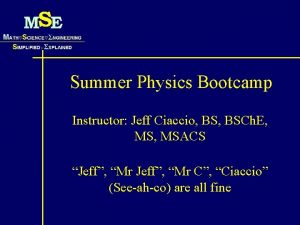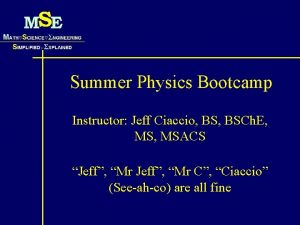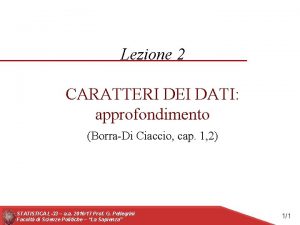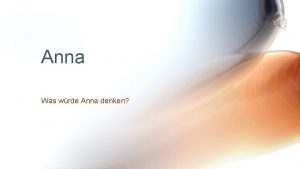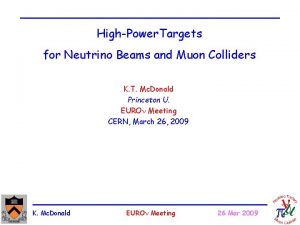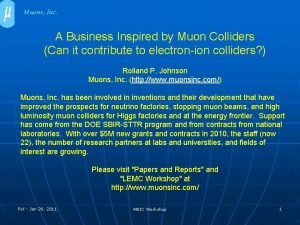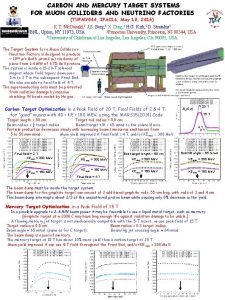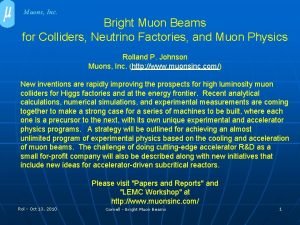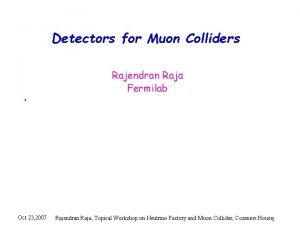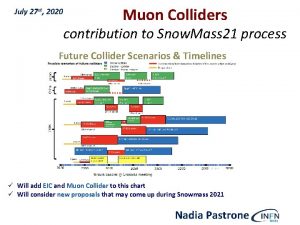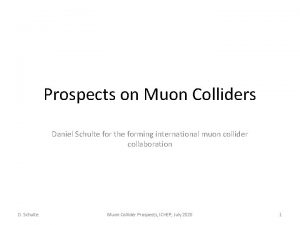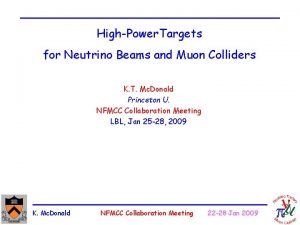Muon detection at Super Colliders Anna Di Ciaccio





































































- Slides: 69

Muon detection at Super. Colliders Anna Di Ciaccio University of Roma “Tor Vergata” and INFN ELOISATRON PROJECT 42 nd Workshop Innovative Detectors for Supercolliders Erice (Trapani), Italy 28 September - 4 October 2003 A. Di Ciaccio 42 nd Workshop on Innovative Detectors for Super. Colliders-Erice-3 October 2003

Outline ● ● ● Physics capabilities at a future Hadron Collider and detector challenges Experimental conditions at the VLHC Muon detection and required momentum resolution for multi. Tev muons The ATLAS and CMS muon systems at the Large Hadron Collider A possible VLHC muon spectrometer Review of muon chamber technologies A. Di Ciaccio 42 nd Workshop on Innovative Detectors for Super. Colliders-Erice-3 October 2003 2

Next in Particle Physics ● Open questions of the Standard Model : – – Higgs boson mass Naturalness or hierarchy problem ● – Known solutions: ● ● The Higgs boson mass is generally not protected against quantum corrections to become of the order of the largest physical mass (Mplanck = 1019 Ge. V). New strong forces at the Te. V scale, Technicolor: strongly disfavoured by LEP/Tevatron data; Supersymmetry in the Te. V region: compatible with LEP and Tevatron data; candidate for cold dark matter; Additional space dimensions, “strong” fundamental gravity, lowering gravity scale from Mplanck ~ 1019 Ge. V to MD ~ 1 Te. V. The LHC should give us some hints in a few years from now ! A. Di Ciaccio 42 nd Workshop on Innovative Detectors for Super. Colliders-Erice-3 October 2003 3

Search for physics beyond the SM ● ● But the LHC will most likely not answer all outstanding questions…. New accelerator projects: – Lepton Colliders (LC) : ● ● ● – ● e+e- √s = 0. 5 ÷ 1. 0 Te. V e+e- √s = 3 ÷ 5 Te. V + - √s < 4 Te. V TESLA, NLC, JLC (2015) CLIC (2025) Muon Colliders Precision measurements of Higgs physics but direct observation limited to the few Te. V scale A new Hadron Collider (40<√s <200 Te. V) is the only in-principle-feasible machine which can explore directly the multi. Te. V (10 -100) energy range A. Di Ciaccio 42 nd Workshop on Innovative Detectors for Super. Colliders-Erice-3 October 2003 4

The Multi. Te. V Frontier ● ● Considering the long time for an accelerator project it is important to start R&D for a VLHC Existing projects: – INFN/ELN ● – US Very Large Hadron Collider ● ● √s =100 -200 Te. V L =1034 -1035 cm-2 s-1 two stage machine (233 Km tunnel) – √s =40 Te. V at L = 1034 cm-2 s-1 – √s =175 Te. V at L = 2 x 1034 cm-2 s-1 Physics – √s = 200 Te. V corresponds to E=2 x 1019 e. V for fixed target experiment ● A. Di Ciaccio Collisions at energy equivalent to the GZK cut-off in cosmic ray!!!! 42 nd Workshop on Innovative Detectors for Super. Colliders-Erice-3 October 2003 5

Physics • The main reason to build the VLHC is not to test SM but the search for new physics Ø explore the ~ 10 Te. V energy scale Ø mass reach up to ~30 -40 Te. V A. Di Ciaccio Ø Heavy particles (Z’, W’) produced with small s : è high luminosity required 42 nd Workshop on Innovative Detectors for Super. Colliders-Erice-3 October 2003 6

Physics at a future hadron colliders • Physics goals for a VLHC – – – New gauge bosons Higgs physics studies Compositness Extradimensions Supersymmetry No Higgs: strong electroweak symmetry breaking Discovery limit for extra neutral gauge bosons for a variety of models A. Di Ciaccio 42 nd Workshop on Innovative Detectors for Super. Colliders-Erice-3 October 2003 7

The experimental enviroment at L=1034 cm-2 s-1 (* relative to LHC) A. Di Ciaccio 42 nd Workshop on Innovative Detectors for Super. Colliders-Erice-3 October 2003 8

Experimental conditions @ 100 Te. V and L > 1034 cm-2 s-1 • Smaller bunch crossing separation • More multiple interactions per bunch crossing fast, higher granularity detectors, faster level 1 trigger • Higher radiation level in the experimental hall more radiation hard electronics high rate capability of the detectors careful study of detectors ageing higher occupancy of tracking detectors A. Di Ciaccio 42 nd Workshop on Innovative Detectors for Super. Colliders-Erice-3 October 2003 9

Muon detection ● Muons are unique as charged particles in their great penetrating power. Crucial signature for many low rate physics processes – ● Higgs production, new heavy Z and W bosons, high mass DY, Supersymmetry etc) After sufficient material of the calorimeters particles rates are low enough – Enable trigger and momentum measurements up to the highest luminosity v Emphasis on the talk will be on high energy muon measurement outside the central tracking A. Di Ciaccio 42 nd Workshop on Innovative Detectors for Super. Colliders-Erice-3 October 2003 10

Muon detection at the VLHC (1) ● Challenging performance in muon detection at the VLHC: – charge measurement: ● – momentum measurement with: ● ● – Massive new particles (W’, Z’) charge asymmetry dp/p < 10% up to 10 Te. V muons dp/p ≈ 50% for 10 Te. V muons in ATLAS and CMS at LHC ->Need a factor 5 improvement If the muons are measured, ETmiss measurements could be done: ● A. Di Ciaccio crucial for studying strong WW scattering, supersymmetric particle searches 42 nd Workshop on Innovative Detectors for Super. Colliders-Erice-3 October 2003 11

Muon detection at the VLHC(2) ● Muon detector requirements: – – – ● Source of muon backgrounds: – – – ● Muon identification Charge assignment Muon trigger at Level 1 and Level 2 Beam crossing identification Good muon momentum measurement up to ~10 Te. V p and K decay in the central tracking Punchtrough Low energy background (neutrons and photons) in the detector hall -> shielding in the forward region Multi. Te. V energy muon: “catastrophic” energy losses A. Di Ciaccio 42 nd Workshop on Innovative Detectors for Super. Colliders-Erice-3 October 2003 12

Muon energy loss in dense materials • Very high energy muons behave like electrons at low energy v E R • Large energy losses (bremsstrahlung, pair productions, nuclear interactions) in calorimeters and a possible iron yoke of the muon spectrometer (Ecritical =330 Ge. V in iron) produce: • incorrect muon momentum measurements • position measurement difficult (overlap between muon tracks and e. m. showers in muon detectors ) A. Di Ciaccio 42 nd Workshop on Innovative Detectors for Super. Colliders-Erice-3 October 2003 13

Muon momentum measurements ● ● Muon detector in a magnetic field B Momenta are reconstructed by measuring the sagitta s – ● s = 0. 3 B L 2 / 8 p for a track at 90° to the beam s(meter), B(Tesla), p (Ge. V/c) For a good momentum resolution – A. Di Ciaccio B and L must be made large 42 nd Workshop on Innovative Detectors for Super. Colliders-Erice-3 October 2003 14

Muon momentum resolution ● ● Parameterization of muon momentum resolution – ds/s = dp/p = √ (ap)2+ b 2 The term b depends from multiple scattering èLimits ● the resolution at low momentum The term a is determined by systematic alignment errors and intrinsic muon chamber spatial resolution èLimits A. Di Ciaccio high momentum measurements 42 nd Workshop on Innovative Detectors for Super. Colliders-Erice-3 October 2003 15

Muon momentum resolution (a) Excellent chamber spacial resolution (b) Minimize the material A. Di Ciaccio Large magnetic volume required 42 nd Workshop on Innovative Detectors for Super. Colliders-Erice-3 October 2003 16

ATLAS & CMS at the LHC ● The LHC muon systems are a good starting point to design a muon system for at least a stage-I VLHC: – ATLAS muon spectrometer ● – CMS muon spectrometer ● A. Di Ciaccio stand alone air-core toroids compact solenoid with iron yoke 42 nd Workshop on Innovative Detectors for Super. Colliders-Erice-3 October 2003 17

Toroidal B field ● Good: – – – ● Larger rapidity coverage with respect to a solenoid field Field line perpendicular to the particle trajectories Bending power increases as Bending power follows the increasing p forward rapidity at fixed p. T Closed field->no need for massive iron for flux return Bad: – – A. Di Ciaccio Field free-region around the vertex ( need an additional solenoid to measure momentum in the inner tracker) Design of tracking chambers complicated by the coils that surround the field volume 42 nd Workshop on Innovative Detectors for Super. Colliders-Erice-3 October 2003 18

Solenoidal B field ● Good: – ● A solenoidal field configuration provides azimuthal symmetry and simplifies detector construction Bad: – The transverse bending power decreases in the forward region once the particles no longer traverse the total field volume – Large mass of iron to return the flux A. Di Ciaccio 42 nd Workshop on Innovative Detectors for Super. Colliders-Erice-3 October 2003 19

The ATLAS Muon Spectrometer ATLAS at LHC: multi-purpose detector to search for Higgs and new physics Muon Spectrometer: • toroidal magnetic field: <B> = 0. 4 T high pt-resolution independent of the polar angle • size defined by a large lever arm to allow high stand-alone precision • air-core coils to minimise the multiple scattering • 3 detector stations - cylindrical in barrel - wheels in end caps • coverage: | | < 2. 7 A. Di Ciaccio Weigth: 7000 t Muon technologies: • fast trigger chambers: TGC, RPC • high resolution tracking detectors: MDT, CSC 42 nd Workshop on Innovative Detectors for Super. Colliders-Erice-3 October 2003 20

The ATLAS magnetic system Ø Superconducting central Solenoid for momentum measurement in the ID Ø 3 superconducting air toroids for stand-alone momentum measurement BT Parameters : • 25. 3 m length • 20. 1 m outer diameter • 8 coils • 1. 08 GJ stored energy • 370 tons cold mass • 830 tons weight • 56 km Al/Nb. Ti/Cu conductor • conductor cooled at 4. 7 K A. Di Ciaccio 7 years construction 98 -05 42 nd Workshop on Innovative Detectors for Super. Colliders-Erice-3 October 2003 21

Superconducting Toroids 25 m A. Di Ciaccio 10 m 42 nd Workshop on Innovative Detectors for Super. Colliders-Erice-3 October 2003 22

Barrel Toroid 8 coils 25 x 5 m B L 2 ~ 15 T m 2 A. Di Ciaccio s. MDT = 50 mm 42 nd Workshop on Innovative Detectors for Super. Colliders-Erice-3 October 2003 Dp/p ~ 30% at 3 Tev/c 23

End-Cap Toroid Services Turret 8 Magnet Coils (4. 5 K) Thermal Radiation Shield (80 K) Vacuum Vessel (300 K) B L 2 ~ 25 T m 2 A. Di Ciaccio s. MDT = 50 mm 42 nd Workshop on Innovative Detectors for Super. Colliders-Erice-3 October 2003 Dp/p ~ 21% at 3 Tev/c 24

The muon momentum measurement Trigger chambers and 2 nd coordinate Precision Measurements in 3 locations in the bending plane A. Di Ciaccio 42 nd Workshop on Innovative Detectors for Super. Colliders-Erice-3 October 2003 25

Performance Momentum resolution vs p. T Momentum resolution vs h chamber resolution: 50 µm monitoring of high mechanical precision during production alignment at 1 Te. V: elaborate optical system to monitor dp/p = 10% sagitta = 500 µm chamber deformations and displacements A. Di Ciaccio 42 Workshop on Innovative Detectors for Super. Colliders-Erice-3 October 2003 26 nd

CMS: a Compact Solenoidal Detector Long Solenoid L =13 m Large Bore R = 2. 95 m Strong Field B =4 T Iron return yoke houses the barrel and the endcap muon chambers Total weight: 12500 t A. Di Ciaccio 42 nd Workshop on Innovative Detectors for Super. Colliders-Erice-3 October 2003 27

Barrel CMS compact muon solenoid 5 wheels with 4 muon stations located in the pockets of the iron magnet return yoke. Each station is made by 1 DT and 2 RPCs on MB 1, MB 2, and 1 DT and 1 RPC on MB 3, MB 4 A. Di Ciaccio 42 nd Workshop on Innovative Detectors for Super. Colliders-Erice-3 October 2003 28

Muon reconstruction A. Di Ciaccio 42 nd Workshop on Innovative Detectors for Super. Colliders-Erice-3 October 2003 29

CMS muon momentum resolution Stand-alone momentum resolution with vertex constraint Dp/p dominated by multiple scattering in iron nd A. Di Ciaccio Muon system with inner tracker 42 Workshop on Innovative Detectors for Super. Colliders-Erice-3 October 2003 30

Extrapolating ATLAS muon system for a VLHC dp/p= 10% at 10 Te. V Chamber resolution and alignment error dominant for high momentum A. Di Ciaccio 42 nd Workshop on Innovative Detectors for Super. Colliders-Erice-3 October 2003 31

A possible VLHC detector MUON SYSTEM 12 m Fermilab-TM-2149 A. Di Ciaccio 42 nd Workshop on Innovative Detectors for Super. Colliders-Erice-3 October 2003 32

A possible VLHC muon spectrometer ● A larger muon system (8 -12 m radius ) could reaches a muon momentum resolution of 10% for 10 Te. V muons using present muon detectors – – A spectrometer similar to ATLAS could in principle be used for a VLHC experiment CMS design is not optimal for the reasons: ● ● ● Muon chamber detection in iron problematic ->large energy losses Large amount of iron needed as return yoke A large solenoid with muon chambers inside (as for the LEP-L 3 experiment) could in principle reach the design goal with: – A ~30 m diameter solenoid (i. e. with B=0. 75 T and L=12 m) plus a huge external iron return yoke (>100. 000 t of iron!) A. Di Ciaccio 42 nd Workshop on Innovative Detectors for Super. Colliders-Erice-3 October 2003 33

Muon technologies ATLAS muon detectors – Tracking Chambers : ● – MDT, CSC Trigger Chambers ● RPC, TGC CMS muon detectors – Tracking chambers ● – Trigger chambers ● A. Di Ciaccio DT, CSC DT, RPC, CSC 42 nd Workshop on Innovative Detectors for Super. Colliders-Erice-3 October 2003 34

The ATLAS muon Spectrometer-Front view 4 technologies • Trigger • RPC barrel region • TGC forward • Precision chambers • MDT | h | < 2. 0 • CSC 2. 0 < | h | < 2. 7 A. Di Ciaccio 42 nd Workshop on Innovative Detectors for Super. Colliders-Erice-3 October 2003 35

The ATLAS muon Spectrometer-Side view Barrel End-cap Interaction point Reduce hall background A. Di Ciaccio d from int. point (m) 42 nd Workshop on Innovative Detectors for Super. Colliders-Erice-3 October 2003 36

The ATLAS muon detector 3 D view MDT: 5500 m 2 RPC: 3650 m 2 TGC: 2900 m 2 CSC: 29 m 2 --------------- 12079 m 2 A. Di Ciaccio 42 nd Workshop on Innovative Detectors for Super. Colliders-Erice-3 October 2003 37

Monitored Drift Tubes Specifications of the ATLAS spectrometer tracking system: ü 3 point measurements (3 muon stations); s = 50 m/station üModerate radiation length (0. 1 -0. 2 x/X 0) üFast (< 1 ms ) and with high rate capability (> 100 Hz/cm 2) üLow ageing ( survival time > 10 years of operation in the LHC background) MDT detector: ØDrift tube: 3 cm diameter, l =1. 5 -5. 0 m. Al wall 400 mm thick. Ø 2 multilayers of tubes with 20 -30 cm separation, 3 -4 layers of tubes each. ØGas : Ar-CO 2 (93 -7%) at 3 bars absolute (~700 ns drift; ~70 -80 mm space resolution/tube, G=2 104) 30% occupancy max. A. Di Ciaccio 42 nd Workshop on Innovative Detectors for Super. Colliders-Erice-3 October 2003 38

Monitored Drift Tubes Multilayer Tube end-plug: • Wire location < 10 mm • Gas in/out. Gas tightness ~10 -8 bar l/s A. Di Ciaccio • HV and signal handling 42 nd Workshop on Innovative Detectors for Super. Colliders-Erice-3 October 2003 39

Monitored Drift Tube: Mechanical construction Contribution to the error: required precision/station s = 50 mm ü Intrinsic single tube space resolution ~ 100÷ 70 mm 3 x 2 tubes 40 mm üR-t relation from autocalibration 10 mm üMechanical precision on wire location 20 mm üMDT location in space (alignment) 20 mm 50 m Assembly procedure must guarantee 20 mm wire location at the two tube ends. Wire tension control at % level ~ 5 mm uncertainty on wire gravitational sag. A. Di Ciaccio 42 nd Workshop on Innovative Detectors for Super. Colliders-Erice-3 October 2003 40

MDT Chamber A. Di Ciaccio 42 nd Workshop on Innovative Detectors for Super. Colliders-Erice-3 October 2003 41

Alignment system üDesigned to correct for 3 D movements of the chambers after installation. üBased on straightness monitors Rasnik with ~ 1 m accuracy 1) in-plane A. Di Ciaccio 2) axial 3) projective 42 nd Workshop on Innovative Detectors for Super. Colliders-Erice-3 October 2003 42

Alignment system: Rasnik üProjective aligment: ü Mask in inner station ü Lens in middle station ü Camera in outer station ü Monitor the image of the mask in regular interval and store on a PC ü 1 m precision A. Di Ciaccio 42 nd Workshop on Innovative Detectors for Super. Colliders-Erice-3 October 2003 43

Single tube: Measured Resolution Fit tracks using 5 out of 6 measured points. Extrapolate the tracks to the tube not used in the fit Define the residual for this tube as Res=Rfit-Rmeasued Garfield Simulation • Single Tube averaged resolution: 70 m 100 m A. Di Ciaccio 42 nd Workshop on Innovative Detectors for Super. Colliders-Erice-3 October 2003 44

MDT Resolution with background rate Test beam results at X 5 -GIF Space charge effect • degradation of the resolution for large drift radii Improve MDT resolution for the VLHC • smaller radius tube • faster gas A. Di Ciaccio 42 nd Workshop on Innovative Detectors for Super. Colliders-Erice-3 October 2003 45

MDT ageing § A MDT operated with gas circulation after a long-term irradiation showed large reduction in pulse height within the first ~30 cm from gas input side already for accumulated charge ~ 40 m. C/cm (Atlas spec: 0. 6 C/cm) L = 30 cm from gas inlet furthest away from gas inlet (L=130 cm) § Electron microscopy of the wire surface: silicon deposit on wire near the gas input § Silicone grease found in the gas system components § Strictly quality control needed for the installation of the MDT gas system A. Di Ciaccio 42 nd Workshop on Innovative Detectors for Super. Colliders-Erice-3 October 2003 46

Resistive Plate Counters ~1. 5 ns HV X readout strips Bakelite Plates Foam Gas Grounded planes RPC operating conditions: • Gas gap: 2 mm E ~ 4. 5 KV/mm • Bakelite plates: 2 mm, r ~2 x 1010 W x cm • Gas working mode: avalanche • Gas mixture: PET spacers Y readout strips Time distribution Graphite electrodes • 94. 7%C 2 H 2 F 4+ 5%iso. C 4 H 10+ 0. 3%SF 6 Performance: • Single gap efficiency (with spacers ): e = 97% s = 2 ns • Time resolution ~ 1. 5 -2. 0 ns b. x. identification • Rate capability <1 KHz/cm 2 after ageing of 10 ATLAS years reduced rate capability (~ 200300 Hz/cm 2) • (x, y strip readout ) 2 nd coordinate measurement A. Di Ciaccio 42 nd Workshop on Innovative Detectors for Super. Colliders-Erice-3 October 2003 47

RPC ageing test at X 5 -GIF Efficiency vs HV after Q = 0. 35 C/cm 2 (>10 ATLAS years + safety factor 5 -10) Source: 740 GBq 137 Cs E g = 0. 662 Me. V § The RPC module-0 after ageing (>10 Atlas year +safety factor 5 -10) shows a rate capability of ~ 200300 Hz/ cm 2 (expected rate 10 -20 Hz/cm 2) § The ageing effect can be described in term of an increase of the operating voltage, due to an increase of the electrode total resistence § An ageing study on 4 production chambers is now going on at the CERN GIF facility A. Di Ciaccio 42 nd Workshop on Innovative Detectors for Super. Colliders-Erice-3 October 2003 48

X 5 Ageing test status ● ● ● Present integrated ageing is 4. 1 ATLAS years. After 3. 5 ATLAS years (about 100 m. C/cm 2 integrated charge, including a safety factor of 5) all the gas gaps under test show very good detection efficiency even at fully open source. A moderate increase of the resistivity was observed as expected. The rate capability remains much above the ATLAS requirements At the beginning of July the gas closed loop was introduced on 4 out of the 6 tested gas gaps. The gas recirculated fraction is 50% so far and was increased last week to 95%. Since last January all the gas volumes are operated with average 30% RH gas mixture to test the effect on the long term stability of the bakelite resistivity. No negative effects where detected until now. A. Di Ciaccio 42 nd Workshop on Innovative Detectors for Super. Colliders-Erice-3 October 2003 49

RPC beam tests at X 5(3. 5 years) A. Di Ciaccio 42 nd Workshop on Innovative Detectors for Super. Colliders-Erice-3 October 2003 50

Thin Gap Chambers TGC: MWPC with small cathode-cathode distance • Anode pitch: 1. 8 mm • Anode-Cathode dist: 1. 4 mm • Cathode-Cathode dist: 2. 8 mm Operating conditions • Gas : 55 % CO 2 , 45 % N-Pentane • HV: 3. 1 KV • Saturated avalanche mode • Very short drift time due to the thin gap ensures the good time resolution needed for Bunch Crossing ID( 99% efficiency with a 25 ns gate) A. Di Ciaccio • Wire signals used to provide the trigger, strip(15 -40 mm) signals used for the second 42 nd Workshop on Innovative Detectors for Super. Colliders-Erice-3 October 2003 51 coordinate

Cathode Strip Chambers Basic module: 4 layers with x, y read-out A. Di Ciaccio 42 nd Workshop on Innovative Detectors for Super. Colliders-Erice-3 October 2003 52

Cathode Strip Chambers CSC: MWPC with analog strip read-out § Gas mix : Ar-CO 2 (80/20 %) § Gain 104; HV 2. 6 KV § Muon position determined by interpolating the charge induced on 3 to 5 adjacent strips §Precision (x-) strip pitch ~ 5. 6 mm §Measure Q 1, Q 2, Q 3… to get sx ~ 60 m. §Second set of y-strips measure transverse coordinate to ~ 1 cm. § 7 ns time resolution, good two track resolution. §High rate capability (>>1 KHz/cm 2). §Low sensitivity to background n (10 -4), small ageing A. Di Ciaccio S = d = 2. 54 mm W = 5. 6 mm 42 nd Workshop on Innovative Detectors for Super. Colliders-Erice-3 October 2003 53

Level 1 Muon Trigger ØTrigger selection performed both in the bending and non-bending plane to reduce fake trigger rate due to the high background level. Ø Window size in the bending plane defines the accepted p. T interval; in the nonbending plane defined by multiple scattering. Ø Two trigger thresholds : Low pt (6 Ge. V/c threshold) and High pt (20 -40 Ge. V/c threshold) A. Di Ciaccio 42 nd Workshop on Innovative Detectors for Super. Colliders-Erice-3 October 2003 54

Trigger performance Cross sections for prompt muons and punchtrough A. Di Ciaccio Trigger efficiency 42 nd Workshop on Innovative Detectors for Super. Colliders-Erice-3 October 2003 55

Fake trigger rate Background hits in trigger detectors accidental triggers Prompt muons Accidentals rate (nominal background) Accidentals rate (background x 10 ) Good safety margin over accidental trigger rate A. Di Ciaccio 42 nd Workshop on Innovative Detectors for Super. Colliders-Erice-3 October 2003 56

The CMS Muon Detectors A. Di Ciaccio 42 nd Workshop on Innovative Detectors for Super. Colliders-Erice-3 October 2003 57

CMS: longitutinal view A. Di Ciaccio 42 nd Workshop on Innovative Detectors for Super. Colliders-Erice-3 October 2003 58

MUON DT Chambers Electrode strips Cathode Al strips Drift Velocity : ~ 55 m/ns Single Wire Resolution : < 300 m 100 m F , 150 m Q A. Di Ciaccio 42 nd Workshop on Innovative Detectors for Super. Colliders-Erice-3 October 2003 59

DT Local Trigger-Bunch and track Identifier DT Meantimer technique allows bunch-crossing identification and measurements of track parameters 3 out of 4 hits in a SL: MT 1 = 0. 5 * (T 1 + T 3) + T 2 MT 2 = 0. 5 * (T 2 + T 4) + T 3 ØMT = Tdriftmax independent on the track angle and position ØTrue alignment occurs in a shift register at a fixed time ->allow bx identification ØTrack and angle position are given by the alignment of the hits A. Di Ciaccio 42 nd Workshop on Innovative Detectors for Super. Colliders-Erice-3 October 2003 60

DT Performance in magnetic field Resolution Efficiency Resolution < 300 m Efficiency > 99% (for B field conditions expected in CMS) B T • This detector is suitable for a muon spectrometer in iron (large multiple scattering) ->but for the VLHC needed a better chamber resolution A. Di Ciaccio 42 nd Workshop on Innovative Detectors for Super. Colliders-Erice-3 October 2003 61

Conclusions ● ● The technology used for the LHC muon detectors and their successful use is a good starting point for the VLHC. At the VLHC an improvement of the momentum resolution dp/p of a factor 5 is required -> BL 2 150 Tesla m 2 needed ● ● We need a specific R&D programme for: üExtensive ageing studies üMore precision resolution detectors üFaster üCheaper (large surface to cover!!) Current LHC detector technologies were chosen after a successful detector R&D programme launched in early 90’s A. Di Ciaccio 42 nd Workshop on Innovative Detectors for Super. Colliders-Erice-3 October 2003 62

Spectrometer performances • Geometrical acceptance: • Trigger system | h |<2. 4 : low pt =93% high pt=92% • Tracking system | h |<2. 7, 3 points/track : 89. 6% (fake tracks ~0. 1%) Tracking efficiency vs eta A. Di Ciaccio Tracking efficiency vs phi 42 nd Workshop on Innovative Detectors for Super. Colliders-Erice-3 October 2003 63

§ § Dependence of the Resolution on the Pressure Resolution improves with higher pressure § diffusion contribution decreases § smaller cluster position fluctuations (more clusters) § smaller contribution of charge fluctuations (higher threshold) Gas pressure of 3 bars chosen § big improvement 1 3 bars § marginal improvement 3 5 bars § with higher pressures maximum ion drift time grows more space charge (3 5 bars 30% more) Different gas pressures compared keeping the signal/noise ratio constant A. Di Ciaccio 42 nd Workshop on Innovative Detectors for Super. Colliders-Erice-3 October 2003 64

Trigger system v. Three levels of trigger to reach the final output rate of ~ 100 Hz v. Level 1 : bunch crossing identification trigger detectors time resolution << 25 ns v. Level 1 latency time fixed to 2. 5 s v. Level 1 must provide Region Of Interest (ROI) to level 2 A. Di Ciaccio 42 nd Workshop on Innovative Detectors for Super. Colliders-Erice-3 October 2003 65

RPC Ageing Studies A 15 months ageing test performed on module-0 at the GIF – X 5 CERN irradiation facility. GIF-X 5: Uniform irradiation with low energy gamma Source: 740 GBq 137 Cs RPC module-0 E g = 0. 662 Me. V Average expected counting rate in the ATLAS barrel ~100 Hz/cm 2 ( including a safety factor ~ 10) Ø Total counts expected in 10 ATLAS years: 1010/cm 2 Ø Total delivered charge: 0. 3 C/cm 2 Ø A. Di Ciaccio 42 nd Workshop on Innovative Detectors for Super. Colliders-Erice-3 October 2003 66

Full source and source off operating currents n. The source-off currents show also a modest increase which is to a large extent related to the temperature, however, part of this increase is an indication of ageing, which is still irrelevant for the detector performance 23. 2°C-5/9/2003 Closed source n. This ageing effect, due to the extreme conditions of the test (about 40 times the nominal Atlas rate), has been shown to be amplified by high temperature operation (around 30 C) and lower gas flow (< 1 Vol/2 hours) n. We are now observing a very significant decrease of the closed source currents that we 42 correlate to the reduced ageing rate (in the last 2 A. Di Ciaccio Workshop on Innovative Detectors for Super. Colliders-Erice-3 October 2003 67 months) and to the decreasing temperature nd

Closed source current A. Di Ciaccio 42 nd Workshop on Innovative Detectors for Super. Colliders-Erice-3 October 2003 68

Counting rate Open vs. closed source A. Di Ciaccio 42 nd Workshop on Innovative Detectors for Super. Colliders-Erice-3 October 2003 69
 Anna di ciaccio
Anna di ciaccio Wizard lizard superworm
Wizard lizard superworm Núi muôn đời vững chãi
Núi muôn đời vững chãi Muôn thiên thần cánh trắng
Muôn thiên thần cánh trắng Từ muôn phương ta về đây sánh vai lên đường
Từ muôn phương ta về đây sánh vai lên đường Muôn dân mau vỗ tay ngợi khen cha
Muôn dân mau vỗ tay ngợi khen cha ôi giêsu chúa giêsu là vua
ôi giêsu chúa giêsu là vua Muon collider
Muon collider Muon detector
Muon detector Muon g2
Muon g2 Muon token
Muon token Cocine
Cocine Muon
Muon Con xin dâng lên muôn lời suy tôn
Con xin dâng lên muôn lời suy tôn Muốn tính chu vi hình chữ nhật
Muốn tính chu vi hình chữ nhật Ca vang lên nào
Ca vang lên nào Rong nhp
Rong nhp Muon g-2
Muon g-2 Muôốn tìm số chia
Muôốn tìm số chia Cms compact muon solenoid
Cms compact muon solenoid Mênh mông muôn mẫu một màu mưa
Mênh mông muôn mẫu một màu mưa Muon speed
Muon speed Muon collider
Muon collider Cách tính chu vi hình tam giác
Cách tính chu vi hình tam giác Toshiyuki kamioka
Toshiyuki kamioka Nhc vng
Nhc vng Muon-catalyzed fusion
Muon-catalyzed fusion Nho2
Nho2 đến muôn đời con cảm tạ ơn chúa
đến muôn đời con cảm tạ ơn chúa Isis neutron and muon source
Isis neutron and muon source Xin giấu con nơi cánh tay cha
Xin giấu con nơi cánh tay cha Muon
Muon Negative gravitropism
Negative gravitropism Language detection
Language detection Elasticsearch anomaly detection
Elasticsearch anomaly detection Fire detection gas turbines
Fire detection gas turbines Fraud detection conference
Fraud detection conference Deadlock detection and recovery
Deadlock detection and recovery Edge detection
Edge detection Limit of detection formula
Limit of detection formula Anomaly detection for data quality
Anomaly detection for data quality Histograms of oriented gradients for human detection
Histograms of oriented gradients for human detection Non-intrusive pig detection
Non-intrusive pig detection Face detection ppt
Face detection ppt Face detection ppt
Face detection ppt Providential detection meaning
Providential detection meaning High voltage leak detection principle
High voltage leak detection principle Edge tracking by hysteresis
Edge tracking by hysteresis Perceptual expectancy
Perceptual expectancy Cost-effective outbreak detection in networks
Cost-effective outbreak detection in networks Manipulation detection code
Manipulation detection code Crc error detection
Crc error detection Dijkstra scholten algorithm
Dijkstra scholten algorithm Error detection and correction in data link layer
Error detection and correction in data link layer Radar is an acronym for radio detection and
Radar is an acronym for radio detection and Object detection facebook
Object detection facebook Convex hull collision detection
Convex hull collision detection Example of local attraction
Example of local attraction Correcting errors in trial balance
Correcting errors in trial balance Liveness detection
Liveness detection Histograms of oriented gradients for human detection
Histograms of oriented gradients for human detection Crc error detection
Crc error detection Error detection adalah
Error detection adalah Corner detection
Corner detection Paul viola
Paul viola Scnn lane detection
Scnn lane detection Ionic face detection
Ionic face detection Lesson 19 collision detection
Lesson 19 collision detection Burr detection
Burr detection Robust real-time object detection
Robust real-time object detection
